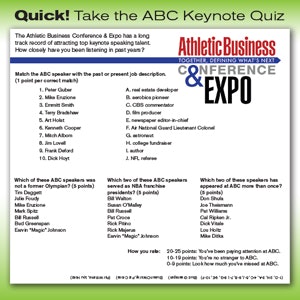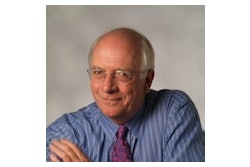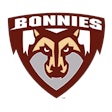
As a twenty-something editor at the Harvard Business Review in the early 1990s, Bill Taylor sensed a pending revolution. Baby boomers were gaining power.

 Click here to take the AB Keynote Quiz
Click here to take the AB Keynote Quiz
Q: What void did Fast Company fill for readers?
A: I think people were beginning to ask all new kinds of questions about what organizations could look like, the nature of power and authority, the demise of hierarchy. We were at a moment when the post-war, command-and-control, you-run-companies-the-same-way-you-run-the-military era was really coming to an end. It really was the age of a couple people in a garage in Silicon Valley developing a piece of hardware or software. You just didn't need global companies with hundreds of thousands of employees to make your mark. So we were at the beginning of a whole new sense of possibility about what companies could look like, how they could run, the kind of information people could have access to. Finally, I do think it was kind of a generational power shift. It was this notion that it was finally the baby boomers' chance to run things, and that had lots of implications for issues of style — what offices looked like, how people dressed. I used to say that Fast Company is really, more than anything, a magazine about the nature of success in a world where people were asking new questions about what it means to be successful in the first place. People just wanted work to feel different, wanted their workplace to work different. And that really gave us the chance to start from scratch, start with a blank sheet of paper, and be the first business magazine born in this era.
Q: What are the biggest challenges facing today's business leader?
A: One of the great challenges today for leaders — whether you're running a health club, whether you're making products that you sell into health clubs, whether you're a high school athletic director — is how do you get your audiences, your constituencies, to pay attention to you in a world that is more oversaturated, overstimulated, overwhelming than ever before. How do you stand out from the crowd in a fatally crowded marketplace? And to me the only way to answer that question is to do things and offer things that are worth paying attention to in the first place. We live in an age now where originality really has become the acid test of anybody's strategy as a leader. For so long, people were content with operating in the middle of the road, trying to be incrementally more competitive, a little bit higher quality. But today, with so much change, so many offerings, so many claims, the middle of the road really is kind of the road to nowhere.
Q: What skills do successful leaders exhibit?
A: Leadership today is about so much more than just the features and functions and economics of what you're presenting to the marketplace or to your constituencies. Whether you're growing a company or running a department, success is all about the emotional and psychological connections you can make with your audience. And it really does put a premium on a different set of skills as a leader and different points of emphasis. So many leaders define their job as making everything efficient, more productive, more reliable. I have no problem with any of that. But ultimately the real challenge for leaders and organizations today is to make everything they do more memorable for the rest of the world to encounter. And that really does put a premium on kind of the performance art of how you do things, and the style and the sense of energy, and the big signals or small gestures you send that say, basically, "You know what? Every time you encounter me, every time you encounter my company, we're going to do a little something that makes you smile, makes you think, that you weren't expecting to encounter.".
Q: Does leadership experience still matter?
A: In a world weighed down by the limits of conventional wisdom, it often takes somebody with a new set of eyes, somebody who hasn't worked for the past 15 years in a health club, somebody who hasn't been sort of struggling in the minutia of being an athletic director for the past 20 years, someone who can see old problems with a new set of eyes and develop a new take. You know, we all grew up in business schools talking about the experience curve — the longer you do something, the better at it you get. We now we live in a world with an inexperience curve. Sometimes the less you know about something frees you up to look at old problems in new ways. Thirty years ago, you sat in your office and you had the ideas, and you rallied the troops and they went off and did the execution. This is not the way the world works anymore.
Q: Where do the best business ideas come from?
A: Today, the issue isn't just the products and services you offer, it's what are the ideas that you stand for as a leader, as a department, as a company? What is the really distinctive point of view you have about what's possible in your field, where your industry is going, what customers or students or parents — whoever the audience is — what people really respond to, value, what's going to move them? What do you see in your field that other people don't see? It's all about the power of ideas. That said, I think it's both unrealistic and exhausting to think that just because you are the leader of a company, the head of marketing, the athletic director of a high school, that means your job is to come up with every idea your company or department needs to come up with, to do all the thinking while your colleagues do the work. We live in a world today in which nobody alone is as smart as everybody together. The real job of a leader is to unearth the best ideas from the quiet genius of employees, to create the conditions under which lots of people get to think together and identify opportunities together, solve problems together, and to be the kind of smart person that other smart people want to rally around and contribute to. But to do that, it's not just, "Let's have a brainstorm." You really have to create what I like to call an architecture of participation. So you make it easy. You make it fun. You make it rewarding. That actually takes a lot of work, but I do think that's one of the new job descriptions of a leader.
This interview was originally published in the September 2014 issue of Athletic Business with the headline, "One on One: Fast Company Co-Founder Talks Publishing, Business Leadership."































